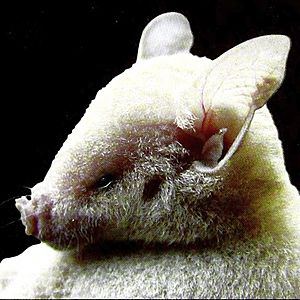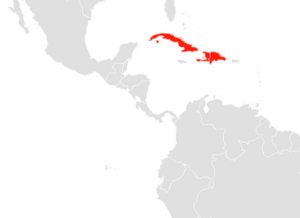Cuban flower bat facts for kids
Quick facts for kids Cuban flower bat |
|
|---|---|
 |
|
| Conservation status | |
| Scientific classification | |
| Genus: |
Phyllonycteris
|
| Species: |
poeyi
|
 |
|
The Cuban flower bat (Phyllonycteris poeyi), also known as Poey's flower bat, is a type of bat. It belongs to the family Phyllostomidae, which includes many different kinds of bats. You can find this bat on the Caribbean islands of Cuba and Hispaniola. Hispaniola is an island shared by two countries: Haiti and the Dominican Republic.
Contents
About the Cuban Flower Bat
The Cuban flower bat is a medium-sized bat. Its wings can spread out between 29 to 35 centimeters (about 11 to 14 inches) wide. These bats usually weigh from 15 to 29 grams (about 0.5 to 1 ounce). Male bats are typically bigger than females. Both male and female bats have soft, grayish-white fur all over their bodies.
They have a short tail, which is less than 18 millimeters (about 0.7 inches) long. The skin between their legs, called the patagium, is quite narrow because they do not have a special spur bone called a calcar. Their snout (nose area) is long and thin. It has a simple nose leaf, which is a fleshy growth around the nostrils.
Special Tongue for Feeding
One cool feature of the Cuban flower bat is its long tongue. The tip of the tongue has a brush-like structure made of hair-like growths. This special tongue helps the bat collect nectar from flowers, which is a big part of its diet.
How They Fly and Communicate
Cuban flower bats fly fairly slowly, around 6.7 kilometers per hour (about 4 miles per hour). The shape of their wings suggests they might find it hard to hover in one spot, unlike some other bats.
These bats use echolocation to find their way around and hunt. Echolocation means they send out sounds and listen for the echoes. This helps them create a "sound map" of their surroundings. Their echolocation calls are usually below 50 kilohertz. These calls can be quite long, lasting up to 7 seconds. However, in tight spaces like caves, they change their calls to be shorter and use a different type of sound called frequency modulated sounds.
Where They Live
The Cuban flower bat lives only in certain places. It is found on Cuba, Hispaniola, and Isla de la Juventud. It also lives on some smaller islands nearby. On Hispaniola, you can find them in both Haiti and the Dominican Republic.
These bats prefer to live in evergreen forests and scrubland. They can be found at heights up to 1,700 meters (about 5,577 feet) above sea level.
Different Types of Cuban Flower Bats
Scientists generally recognize two types, or subspecies, of the Cuban flower bat. Sometimes, these are even thought to be completely separate species:
- Phyllonycteris poeyi poeyi: This type lives in Cuba and Isla de la Juventud.
- Phyllonycteris poeyi obtusa: This type lives on Hispaniola.
Life and Habits
Like most bats, the Cuban flower bat is nocturnal. This means it is active at night and sleeps during the day. During the daytime, these bats gather in large groups called colonies. These colonies can have thousands of bats! They often sleep in narrow, hidden parts of caves.
Sharing Their Home
Cuban flower bats often share their cave homes with other bat species. These can include the Cuban fruit-eating bat, the buffy flower bat, and different kinds of moustached bats.
What They Eat
At night, Cuban flower bats mainly eat seeds and pollen from many different plants. Pollen is a fine powder from flowers. They also eat some flying insects. These bats are very social animals. They often fly in groups of up to thirty individuals when they are out feeding at night.
Who Hunts Them
Some animals hunt Cuban flower bats. Their main predators include barn owls, stygian owls, and Cuban boas.
Baby Bats
Female Cuban flower bats usually have babies once a year, often around December. The exact time it takes for a baby to grow inside the mother is not fully known, but it is likely around six months. A mother bat gives birth to only one baby at a time. The baby is born without fur and weighs about 5 grams (about 0.18 ounces).
See also
 In Spanish: Phyllonycteris poeyi para niños
In Spanish: Phyllonycteris poeyi para niños


